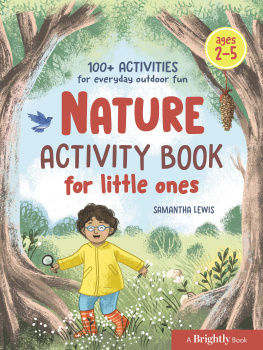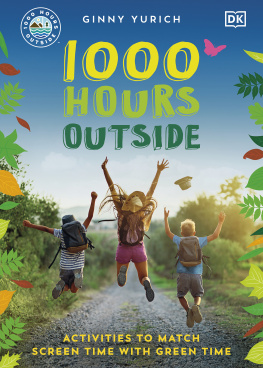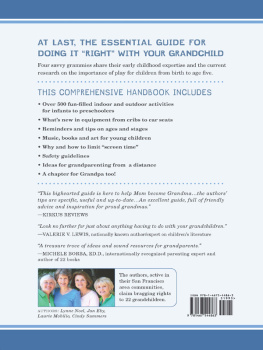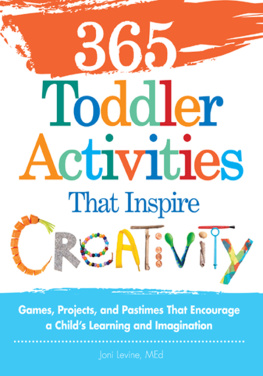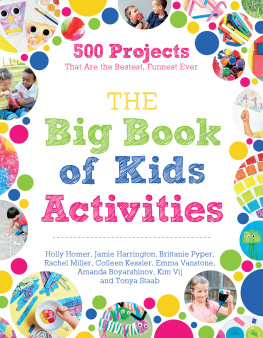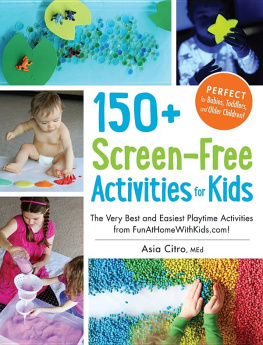Acknowledgments
First, Id like to thank my children. Thank you both for teaching me how to be a kid again and how to find joy in the simple things. A special thank-you to my sweet daughter, whose unwavering support, assistance, and dedication made it possible for her mama to finish this book!
Thank you to my mom, my dad, my husband, and my husbands mom, who all took time off from work to watch the kiddos while I worked on this book. Thank you to my parents, especially my mama, for giving me a magical childhood full of play and for all your help creating one for my children. Thank you to my husband for loving me even though our kitchen and house are always overflowing with art projects, activities, and recipes Im experimenting with, and oh so many boxes of cornstarch and baking soda!
Thank you to my friendsboth those who pushed me to create a blog in the first place (especially you, Rissa!) and those who have so generously spread the word about the blog and now the book. A special thank-you to those of you who loaned out your adorable children for me to photograph.
Thank you to all of my sweet blogging buddies (especially Rachael, Allison, and Stephanie) who have supported me, listened to me talk endlessly about this book, and done so much to help my blog grow along the way.
Thank you to Trish Kuffner and MaryAnn Kohl for creating such a fantastic resource for parents in your many books and for inspiring me as both a mother and an author. Thank you to Maria Ribas for bringing this book and me to Adams Media. And thank you to everyone on the amazing Adams team, especially Diane Garcia, for working so hard to make this book a reality!
Thank you to my readers from all over the world for brightening our days with your stories, photos, and wonderful comments. Thank you for sharing your lives with us!
Thank you to Discount School Supply and Safari, Ltd. for providing us with some of the materials in this book.
APPENDIX A
Scientific Explanations
THE SCIENCE BEHIND IT
Ive added the scientific details of several of the activities to follow for your benefit. If youd like to explain some of these concepts to your children, keep them as simple as possible. A five-year-old wont appreciate or understand the terms endothermic or reactants, but an explanation like sometimes when you mix things together they get cold is just fine. Dont worry about your child understanding the detailed mechanics just yetfocus more on him or her noticing and being curious.
Glow Vitamins, Tonic Water, and Neon Paint
Many naturally occurring substances fluoresce, or emit light, when exposed to ultraviolet light. In this book, we use a black light in a dark room to cause fluorescence. Several of the ingredients in our glow vitamin fluoresce to create the bright yellow-green glow youll see in projects. In tonic water, the ingredient quinine fluoresces blue. Be sure to check for this ingredient when purchasing tonic water for activities. Additionally, most neon paints will also fluoresce in the presence of ultraviolet light; the color they produce will vary by brand.
Black Light
Black lights work by emitting ultraviolet light, specifically in the UVA range (which is the safest type of ultraviolet light). The amount of UVA produced by a single commercially available handheld tube black light is quite low. If you are concerned about exposing your childs eyes to UVA light during any of the glowing activities featured in this book, you can have him or her wear the same sunglasses that he or she wears outside. Sunglasses help block the much greater amounts of UV light produced by the sun.
Endothermic Reactions
For the endothermic reactions in this book, the initial ingredients, or reactants, must absorb energy (heat) from their surroundings in order to keep the reaction going. Because of this heat absorption, the materials will feel cold to the touch both during and right after the reaction takes place. All of the reactants, intermediates, and by-products of the reactions found in this book are safe to touch.
Baking Soda and Citric Acid Powder
When baking soda and vinegar come into contact they react. One of the things this reaction produces is carbon dioxide gas, which forms the fizzing you see in projects like Hatching-Egg Bath Bombs ( ). Citric acid and water will similarly react to produce bubbles of carbon dioxide gas. All of the ingredients (reactants), intermediates, and by-products in these reactions are safe to touch.
If you love the mini explosions baking soda and vinegar make, but hate the smell vinegar leaves behind, you can always stick to using 2 teaspoons citric acid powder (2 packets of Kool-Aid works, too, since it includes citric acid powder) to 1 cup of water in your recipes. If baking soda and vinegar is all you have on hand though, you can mask the sour scent by adding 12 drops of your favorite extract or essential oil into the recipe. I always have a bottle of peppermint extract stashed away for this exact purpose.
Non-Newtonian Fluids
Oobleck is the name most commonly given to the non-Newtonian fluid produced when you mix cornstarch and a liquid. The slimes in this book are also considered non-Newtonian fluids. Non-Newtonian fluids have interesting properties that are fun to investigate: Under pressure theyll behave as a solid; in the absence of pressure theyll behave more like a liquid. Oobleck is not a true liquid, however, as the cornstarch does not dissolve in the waterrather the cornstarch is suspended in the water, which is the cause of its unique behavior. Since the cornstarch will settle out of the water over time, I recommend composting or throwing out these projects, especially Oobleck, when you are done playing, rather than pouring it down a drain.
APPENDIX B
Where to Find the Supplies Listed in the Book
GENERAL SUPPLIES
Sensory bins
If youd like a large sensory bin, you can use a Water or Sand Table (free standing with a closing lid), or you can use an under bed storage container, as shown in the book. You can find under bed storage containers at most superstores in the storage and organization sections or at a specialty storage store. If you are on a tight budget, I recommend using a cake pan, casserole dish, or disposable roasting pan. You can find the disposable roasting pans at grocery stores or the Dollar Tree, or at a superstore, in the cooking supplies aisle.
Cups, spoons, muffin tins, plastic funnels, etc.
You can use items from your own kitchen, or if youd like a dedicated set for your kids, you can find many of these items in the cooking supplies aisle at the Dollar Tree and most superstores.
Splat mat
You can use a waterproof picnic table cover, which can be found at a superstore or party supply store, or 12 yards of oilcloth fabric. Oilcloth can be purchased by the yard on Amazon or at a local fabric store.
Liquid watercolors
We use these as washable alternatives to food dye as well as art supplies. The liquid watercolors pictured in the book are from Discount School Supply and are available through their website. You can also find other brands on Amazon.
Food items
Chances are that you have most of the food items used in this book already stocked in your kitchen. If youre missing one or would like to purchase them exclusively for these recipes, you can find food items such as baking soda, cornstarch, and flour at a grocery store, superstore, or the Dollar Tree.
SLIME SUPPLIES
Glue
Elmers Washable School Glue is the most reliable brand for making our Simple Two-Ingredient Slime. You can find it at grocery stores, craft stores, and superstores.



